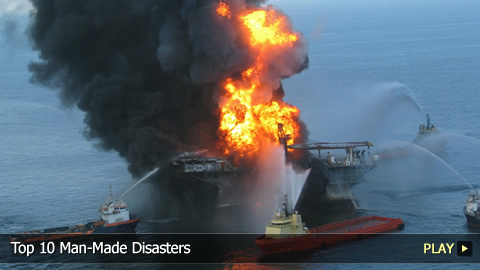Top 10 Man-Made Disasters

- �� Three Mile Island Accident, Dauphin County, Pennsylvania (1979)
- �� Exxon Valdez Oil Spill, Prince William Sound, Alaska (1989)
- �� Dust Bowl or Dirty Thirties, Great Plains, USA and Canada (1934-1936)
- �� Seveso Disaster, Seveso, Italy (1976)
- �� Minamata Disease, Minamata Bay, Japan (1950-60s)
- �� Love Canal Disaster, Niagara Falls, New York (1940-50s/78)
- �� Great Smog of '52 or Big Smoke, London, England (1952)
- �� The Deepwater Horizon Oil Spill, Gulf of Mexico (2010)
- �� Chernobyl Disaster, Chernobyl, Ukraine (1986)
- �� Bhopal Disaster, Bhopal, India (1984)
#10 – Three Mile Island Accident, Dauphin County, Pennsylvania (1979)
Fortunately, when mechanical failures caused a partial nuclear meltdown at the Three Mile Island Nuclear Generating Station, a reactor vessel contained the majority of the released radioactive material. Pregnant women and children were evacuated as a precaution, and fears were only increased by the plot of the unfortunately-timed film “The China Syndrome.” Officials later claimed this accident caused no cancer-related deaths, but some groups dispute this.
#9 – Exxon Valdez Oil Spill, Prince William Sound, Alaska (1989)
The Exxon Valdez oil tanker was transporting 55 million US gallons of oil when it collided with Bligh Reef. Eleven million of those US gallons leaked into Prince William Sound’s waters, and washed up onto 100-plus miles of coastline, killing thousands of birds and marine animals. Even with millions of dollars and a cleanup crew of over 11 thousand, the Alaskan land still wasn’t free from contamination by the early 2000s.
#8 – Dust Bowl or Dirty Thirties, Great Plains, USA and Canada (1934-1936)
Thanks to harsh drought and the deep plowing of the Great Plains topsoil, the dry soil of the North American prairie lands turned to dust and was picked up by heavy winds during the 1930s. The black blizzards that formed were so strong they reached East Coast skies, and destroyed so much farmland that half a million Americans lost their homes, prompting the largest short-term U.S. migration ever.
#7 – Seveso Disaster, Seveso, Italy (1976)
When a valve accidentally burst in an Italian chemical plant, over 2 pounds of the contaminant TCDD was released. The subsequent toxic cloud caused thousands of animals to die and hundreds of people to contract skin lesions, so local produce and livestock were destroyed as a safety measure. This incident paved the way for legislation regulating hazardous substances, and later studies that showed the dioxin to be carcinogenic.
#6 – Minamata Disease, Minamata Bay, Japan (1950-60s)
For over thirty years, The Chisso Corporation was releasing a high concentration of mercury and other chemicals through its factory wastewater into Minamata Bay. This caused an outbreak of Minamata disease to strike thousands of people who had consumed contaminated fish and shellfish. It took twelve years, thousands of affected animals and another outbreak before the Japanese government acknowledged the form of mercury poisoning, which took almost 2000 lives.
#5 – Love Canal Disaster, Niagara Falls, New York (1940-50s/78)
Over about 10 years, Hooker Chemical dumped more than 20 thousand tons of toxic waste into Love Canal. Despite being aware of these dangers, The Niagara Falls City School District built homes and schools on the site during the 1950s. The truth was only uncovered two decades later when journalists linked residents’ major health problems and multiple birth defects to the area’s leaking chemical waste.
#4 – Great Smog of ’52 or Big Smoke, London, England (1952)
After cold weather forced Londoners to burn extra coal in their fireplaces, a thick layer of smog with a high concentration of sulfur dioxide blanketed the city. Due to London’s foggy reputation, the population wasn’t initially alarmed by the smoky black cloud. However, four days of extremely poor outdoor and indoor visibility, disrupted transportation and increased respiratory problems proved fatal: between 4-12 thousand deaths were linked to this event.
#3 – The Deepwater Horizon Oil Spill, Gulf of Mexico (2010)
The biggest accidental oil spill ever occurred after drilling by the BP-operated Deepwater Horizon rig triggered a methane gas explosion. About 210 million US gallons of oil, over 1000 miles of contaminated coastline and 87 days later, the gushing well was finally capped. While BP’s expenses totaled in the billions, the spill’s worst consequences were the fatalities of the explosion, its immeasurable negative health effects and countless marine casualties.
#2 – Chernobyl Disaster, Chernobyl, Ukraine (1986)
After a reactor at the Chernobyl nuclear power station exploded, so much radioactive material was discharged that land in the Ukraine, Russia and Belarus were tainted. Though much flora and fauna was killed off, the most drastic effects of history’s worst nuclear power plant accident were perhaps the 200-plus people with radiation poisoning and the estimated four thousand people who are expected to die from radiation-induced cancer.
#1 – Bhopal Disaster, Bhopal, India (1984)
The world’s worst industrial disaster occurred when toxic gases leaked from the Union Carbide India Limited pesticide plant after malfunctioning safety systems allowed water pressure to build up inside a tank. The resulting gas cloud exposed half a million people to the chemicals. Within hours, thousands had perished while thousands more were injured or developed disabilities. Since the tragedy, thousands more have succumbed to gas-related diseases.
Which do you think is the worst manmade disaster? Be sure to subscribe to WatchMojo.com for more top 10 lists.


 0
0
 0
0
 report
report